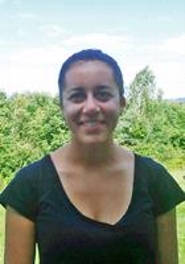
When Clair Cassiello ’11 was younger, she wanted to work for the FBI. The psychological twists excited her – she liked that criminal investigators sometimes analyze how a person thinks as opposed to what crime he has actually committed. Although her ambitions have changed, she still is interested in the profound effect the mind has on actions. This summer, Cassiello is learning more about psychology through an eye-tracking bias project with Visiting Professor of Psychology Mark Oakes.
She and Oakes are looking at how stereotypes and prejudices affect attention and behavior. While stereotypes are present at the unconscious level, they also have more explicit components. In particular, stereotypes cause the eye to focus on certain objects more than others. Where the eye rests is a good indicator of what type of prejudice that person holds.
Cassiello will observe participants’ eye movements while they view scenes in which two actors interact with a stereotyped object. The object will be consistent with the stereotypes associated with one actor, but not the other. For example, a baby would not be consistent with a man, because many people unintentionally see women as primary nurturers. Cassiello and Oakes predict that participants will look longer at the inconsistent object. What they find could either confirm or reject previous assumptions about social construction.
The eye-tracking only occurs within the first few seconds, so Cassiello will need to break this time frame down into even smaller intervals. This will let her see how long a person fixates on an area of interest. She and Oakes will come up with graphs that represent the amount of time participants focus on the inconsistent object, and when during the course of the experiment this is most evident. Subtracting the focus on consistency time from the focus on inconsistency time will give a positive or negative number that she will use for her analysis.
Cassiello says her graphs are beginning to look like cosine curves. This means that in the first three seconds the eyes move spontaneously and haphazardly as they try to interpret data that defy social norms. After that, control processes kick in and the eyes acknowledge the consistent pair of objects. The eye continues to oscillate between the consistencies and inconsistencies, but not as frequently. The nature of this process will give Cassiello an idea of how stereotypes and prejudices operate at an unconscious level, and how this affects attention.
If they can partition the first three seconds of eye movement into intervals of 300 milliseconds, Cassiello and Oakes will have graphs that portray a significantly more concrete awareness of stereotypes. Cassiello is unsure about her post-Hamilton education but is debating between graduate school and law school. She thinks her work this summer could help her regardless of what route she takes. “I really enjoy this type of research because it’s more applied,” she said. “We will actually be able to understand the cognitive processes of the social scene.”
Cassiello is a graduate of Newburgh Free Academy.
She and Oakes are looking at how stereotypes and prejudices affect attention and behavior. While stereotypes are present at the unconscious level, they also have more explicit components. In particular, stereotypes cause the eye to focus on certain objects more than others. Where the eye rests is a good indicator of what type of prejudice that person holds.
Cassiello will observe participants’ eye movements while they view scenes in which two actors interact with a stereotyped object. The object will be consistent with the stereotypes associated with one actor, but not the other. For example, a baby would not be consistent with a man, because many people unintentionally see women as primary nurturers. Cassiello and Oakes predict that participants will look longer at the inconsistent object. What they find could either confirm or reject previous assumptions about social construction.
The eye-tracking only occurs within the first few seconds, so Cassiello will need to break this time frame down into even smaller intervals. This will let her see how long a person fixates on an area of interest. She and Oakes will come up with graphs that represent the amount of time participants focus on the inconsistent object, and when during the course of the experiment this is most evident. Subtracting the focus on consistency time from the focus on inconsistency time will give a positive or negative number that she will use for her analysis.
Cassiello says her graphs are beginning to look like cosine curves. This means that in the first three seconds the eyes move spontaneously and haphazardly as they try to interpret data that defy social norms. After that, control processes kick in and the eyes acknowledge the consistent pair of objects. The eye continues to oscillate between the consistencies and inconsistencies, but not as frequently. The nature of this process will give Cassiello an idea of how stereotypes and prejudices operate at an unconscious level, and how this affects attention.
If they can partition the first three seconds of eye movement into intervals of 300 milliseconds, Cassiello and Oakes will have graphs that portray a significantly more concrete awareness of stereotypes. Cassiello is unsure about her post-Hamilton education but is debating between graduate school and law school. She thinks her work this summer could help her regardless of what route she takes. “I really enjoy this type of research because it’s more applied,” she said. “We will actually be able to understand the cognitive processes of the social scene.”
Cassiello is a graduate of Newburgh Free Academy.
Posted August 16, 2009
